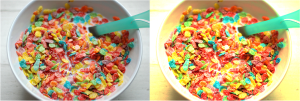

While flipping through the RCL course book today, I came across a section dedicated to explaining how pathos can be generated through many different sources, some of which I’d never considered. Obviously, we can find visual pathos in photos and other media sources (ever seen that tear-jerker SPCA commercial with Sarah McLachlan and the one paraplegic pets?). But a large portion of this chapter considers the pathos of color.
I guess the idea of colors having emotional associations isn’t far fetched. I’ve heard of schools painting classrooms different colors to try to improve students’ moods and learning abilities, and of restaurants avoiding the use of blue plates because apparently blue suppresses appetite. But the book says that our emotional associations with colors are individually and, even for each person, are not fixed; rather, they depend on the context in which an individual sees the colors. The examples in the book are black and white, so I couldn’t really test myself on how the two color variations of the poster shown influence my response to its message. Instead, I decided to try it out myself.
My favorite cereal, Fruitty Pebbles, uses bright coloration to attract kids’ attention. So it makes sense that it probably wouldn’t be in their best interest to advertise in black and white. Just look at the picture I’ve posted. Which would you rather eat? If you’re like me (and you’re attracted to all things rainbow), you’ll definitely pick the one on the left.
But what about variations in coloration? The book mentions that to analyze and use color rhetorically, we use our cultural knowledge and our perception of hue, saturation and brightness. I decided to try changing around these aspects of the coloration of the cereal bowl picture a little, and seeing what effect these changes had on my appetite for the picture. Take a look for yourself at the second picture. Personally, I prefer the picture on the left still. The crisp, white color of the milk in that version is what sold me.
The use of visual pathos is not always as obvious as it is in the McDonald’s commercial with the group of forever-smiling children who’ve just been handed their Happy Meals. When we see are shown emotion, we usually feel similar emotions in response because we know these emotions ourselves. Less obvious sources of pathos, like color choice, are important advertising devices that, if used correctly, can be powerful rhetorical tools.
One of my career interests, consumer behavior research, is actually very concerned with this topic. Believe it or not, the majority of snap judgments made about products are based on color alone. When it comes to picking the best color, predicting consumer reaction to the correctness of color for a particular product is even more important than the color itself. For instance, if you know John Deere tractor owners buy the product in order to feel rugged, you would stray away from the pink sparkle edition when designing that product.
When designing products or advertisements, in order to analyze the use of colors, it might be tempting (and maybe at times, helpful) to identify the emotions or bodily responses you yourself feel. Yet you must be alert to how the differing backgrounds of others might influence their responses. In other words, as with all rhetorical interactions, you must be cognizant of your audience.
1. “White Fruity Pebbles | Jamba Juice Secret Menu – #SecretMenuholic.”#SecretMenuholic.
Secretmenuholic.com, 4 Mar. 2014. Web. 16 Sept. 2014.